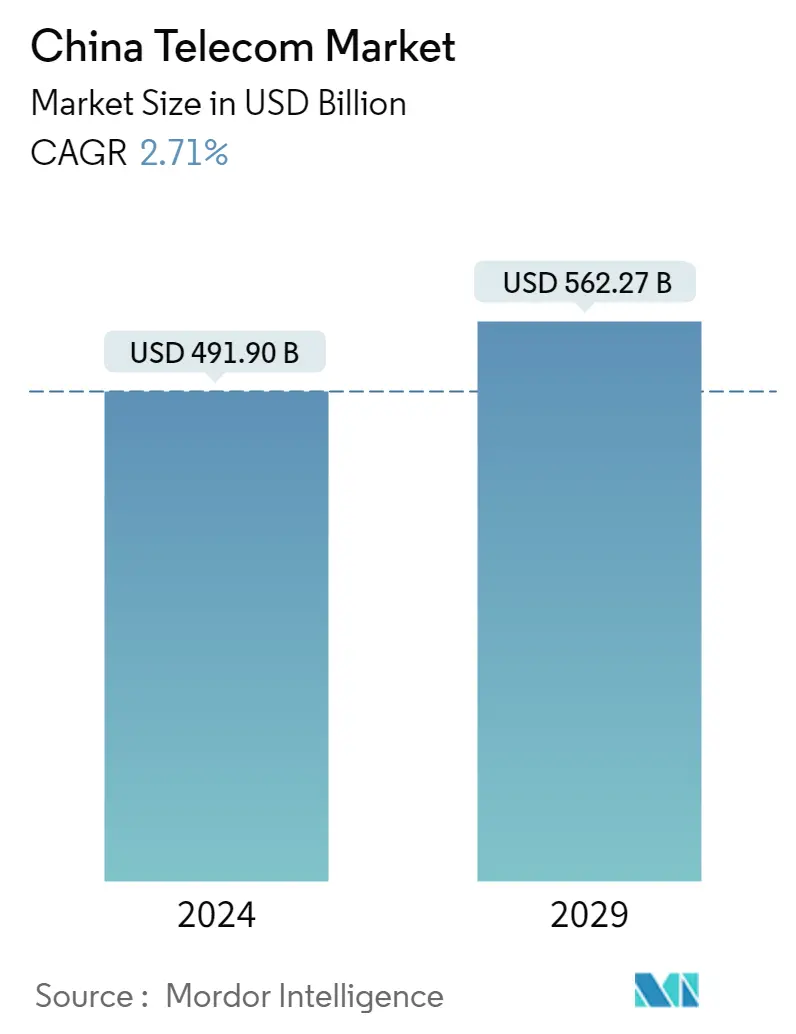China Mobile
China’s telecom industry business revenue at $218B or +6.9% YoY
China’s Ministry of Industry and Information Technology (MIIT) said that in the first eleven months of 2023, the telecommunication industry’s collective business revenue soared to 1.55 trillion yuan, approximately 218 billion U.S. dollars, marking a 6.9% year-on-year increase.
Emerging sectors such as big data, cloud computing, and the Internet of Things (IoT) have shown significant growth. China’s three state owned network providers, China Telecom, China Mobile, and China Unicom have leveraged these technologies to catalyze a 20.1 percent surge in revenue from these areas, amounting to 332.6 billion yuan.
Cloud computing and big data have experienced explosive growth. Revenue from cloud computing surging by 39.7 percent and big data by 43.3 percent compared to the previous year. These figures underscore the central role of data-driven technologies in powering China’s telecom industry forward.
Broadband internet services continue to be a strong revenue stream for the three telecom giants, generating 240.4 billion yuan from January to November, which is an 8.5 percent increase year on year. This growth reflects the increasing demand for high-speed internet across China, as the country continues to embrace digital transformation in all sectors.
In conclusion, China’s telecommunication industry’s growth narrative in 2023 is not just a story of numbers but a chronicle of technological evolution and its integration into the fabric of society. With emerging sectors leading the charge, the industry’s upward trajectory seems poised to continue, as these technologies become increasingly embedded in the everyday lives of businesses and consumers alike.
……………………………………………………………………………………………………………
Separately, Mordor Intelligence forecasts the China Telecom Market size is expected to grow from USD 478.92 billion in 2023 to USD 547.43 billion by 2028, at a CAGR of 2.71% during the forecast period (2023-2028).

References:
https://english.news.cn/20231223/36996f5176e24d48a5677ddc160c99a5/c.html
China’s Telecom Sector Soars with Big Data and Cloud Computing Growth
https://www.mordorintelligence.com/industry-reports/china-telecom-market
China Mobile verifies optimized 5G algorithm based on universal quantum computer
China has achieved the country’s first algorithm verification of a communication network optimization based on a universal quantum computer, according to the Quantum Computing Engineering Research Center in east China’s Anhui Province.
China Mobile, the country’s largest mobile carrier, is currently in the stage of 5G network operation and 6G research and development. Compared with 5G, 6G will face computing problems such as larger-scale business optimization, network optimization, signal processing and machine learning, bringing about great pressure to the classical computation and algorithms, said Cui Chunfeng, an official from the China Mobile Research Institution (CMRI).
The tremendous computing power is the main characteristic of quantum computers. “We try to start from small-scale problems in some typical scenarios to evaluate and verify the application feasibility of quantum computing in communication networks, especially in 6G,” Cui said.
The CMRI and the Origin Quantum Computing Technology Corporation signed a cooperation memorandum on June 30 to jointly promote the integration of quantum computing into the communication network and arithmetic network as the core of the mobile information network.
Aiming at the optimization of large-scale antenna parameters of 5G base stations, the Origin Quantum has preliminarily proved the feasibility of quantum algorithm in the specific problem through effective modeling, algorithm design and real-machine verification, said Dou Manghan, director of the software center of the Origin Quantum.
He noted that the company has the country’s first case of using quantum computers with real machines for communication network algorithm verification, achieving a good start for the application of quantum computing.

A quantum computer in China Photo: VCG
In the future, China Mobile will design quantum algorithms with better performance, boost the integrated development of quantum computing and communication industry, and explore a leapfrog path for the development of mobile information networks, Cui said.
Source(s): Xinhua News Agency
References:
Omdia: China’s 5G network co-sharing + cloud will create growth opportunities for Chinese service providers
After building the world’s largest 5G network with 2.3 million 5G base stations by the end of 2022, China is on track add over 600,000 5G base stations and reach 2.9 million by the end 2023, according to new Omdia market research (owned by Informa). A key milestone in terms of China’s co-building and co-sharing 5G networks recently took place in May 2023, through the 5G network collaboration between all the four service providers in China. Under the organization and guidance of the Ministry of Industry and Information Technology (MIIT), the four major mobile operators in China – China Mobile, China Telecom, China Unicom, and China Broadnet, jointly announced the launch of what they claimed as the world’s first 5G inter-network roaming service trial. The service enables customers to access other telecom operators’ 5G networks and continue using 5G services when outside the range of their original operators’ 5G network.
Ramona Zhao, Research Manager at Omdia said: “Omdia expects inter-network roaming to improve operators’ 5G network coverage particularly in rural areas. Driven by better 5G network coverage, 5G will overtake 4G’s leading position and become the largest technology in China’s mobile market by 2026. By the end of 2028, we anticipate 5G will account for 65.1% of the total mobile subscriptions (including IoT connections).”

An advertisement for 5G mobile service at Shanghai Pudong International Airport. Image Credit: DIGITIMES
Omdia deems China as a 5G pioneer in terms of many areas, including technology innovation, network deployment, and 5G use cases. Driven by the increasing 5G adoption, Chinese service providers’ mobile service revenue and reported mobile (non-IoT) ARPU have all achieved year-on-year (YoY) growth in 2022. China Telecom reported an increase of 3.7% in its mobile service revenue; China Unicom‘s mobile service revenue saw a YoY increase of 3.6%; while China Mobile’s mobile service revenue also increased by 2.5% YoY.
Owing to the digital transformation demand from various state-owned enterprises, cloud services are also considered a growing business for Chinese service providers.
“Omdia recommends that Chinese service providers innovate more applications through the integration of cloud and the 5G network. This will be vital to enable the digital transformation of various industries and the acquisition of new revenue streams,” concludes Zhao.
According to a previous GSMA report, dubbed “The Mobile Economy China 2023”, 5G technology will add $290 billion to the Chinese economy in 2030, with benefits spread across industries.
“Mainland China is the largest 5G market in the world, accounting for more than 60% of global 5G connections at the end of 2022. With strong takeup of 5G among consumers, the focus of operators is now increasingly shifting to 5G for enterprises. This offers opportunities to grow revenues beyond connectivity in adjacent areas such as cloud services – a segment where operators in China have recently made significant progress,” the GSMA report reads.
5G will overtake 4G in 2024 to become the dominant mobile technology in China, according to the report. “4G and 5G dominance in China means legacy networks are now being phased out. While most users have been migrated to 4G and 5G, legacy networks continue to support various IoT services. However, some estimates suggest that legacy networks could be almost entirely shut down in China by 2025,” the study reads.
Chinese vendor Huawei Technologies has secured over half of a major contract to deploy 5G mobile base stations for local carrier China Mobile, according to recent reports by Chinese media.
Huawei obtained over 50% of the total of China Mobile’s centralized procurement program in 2023.
The report also stated that Huawei will provide 5G base stations for different frequency bands. The bands ranging from 2.6 GHz to 4.9 GHz will have around 63,800 stations, divided into two projects, while the number of base stations to operate in the 700 MHz band will be 23,100, divided into three projects. ZTE was the second-biggest winner in terms of base stations, followed by Datang Mobile Communications Equipment, Ericsson and Nokia Shanghai Bell.
References:
China Mobile to deploy 400G QPSK by the end of 2023
China Mobile is preparing to deploy 400G optical links and expects to call its first tenders by the end this year. At the 2023 China Optical Network Symposium on Thursday, Li Han, director of the Basic Network Technology Research Institute of China Mobile Research Institute , gave a speech and revealed that China Mobile has confirmed the availability of 400G technology and will start the centralized procurement of 400G products at the end of this year to promote 400G to enter the commercial stage. “It’s time for 400G, and the industry is looking forward to it.”
 China Mobile completed the world’s first 400G QPSK pilot with vendor partner ZTE in March, achieving high-speed transmission over 5,616 kilometers of ultra-long-distance land real-time live network transmission. The verified computing power network 400G all-optical network technology is the core technology of the next-generation intergenerational evolution of the backbone transport network.
China Mobile completed the world’s first 400G QPSK pilot with vendor partner ZTE in March, achieving high-speed transmission over 5,616 kilometers of ultra-long-distance land real-time live network transmission. The verified computing power network 400G all-optical network technology is the core technology of the next-generation intergenerational evolution of the backbone transport network.
Li Han believes that 400G is an intergenerational technology of optical communication and a disruptive technology. The reason is that 400G optical communication has entered the broadband era, and the C6T+L6T band is disruptive to the entire system including core optical devices. Specific to the application scenario, the backbone network considers the long distance and adopts the QPSK method, and the metropolitan area network considers the cost, and mainly deploys 16QAM-PCS or 16QAM. In different scenarios, different techniques are used.
China Mobile’s 400G research and development has gone through 5 years. From 2018 to 2021, it will mainly study 16QAM-PCS or 16QAM; in 2022, with the development of 130G baud rate optical modules, the industry chain will turn to QPSK driven by the three major manufacturers. This is of decisive significance to the development trend of 400G.
Li Han finally emphasized that 400G still needs to continue to improve technology, such as EDFA, which needs to substantially integrate C-band and L- band . In terms of optical fiber , research on anti-resonant hollow-core optical fiber should be promoted.
In a white paper, China Mobile said Jiuzhou would encompass 400G optical connectivity and a distributed cloud architecture, with edge computing and three levels of latency, from 1 millisecond in the city to 20 milliseconds in the countryside. The paper said the 400G OTN would initially be deployed at major computing hub nodes, then in the backbone.
A major driver of China Mobile’s optical plans is a government scheme to build out China’s national “computing power network” – a chain of data centers and high-speed fiber links that will support the new computer-intensive era of AI, deep learning, 5G Advanced and the industrial Internet.
One key part of this is the East-West plan, in which data from the industrialized eastern seaboard is being hauled to lower cost, renewables-powered data centers in the less developed west over high-speed links. So far China Mobile has deployed more than 40 super-large data centers with more than 1.3 million racks and over 1,000 edge nodes.
Li said the telco’s 400G R&D had initially focused mainly on 16QAM-PCS and 16QAM, but last year had turned to QPSK, driven by breakthroughs from three domestic vendors.
Zhang Bin, vice president of FiberHome’s network business unit, said he believes 400G OTN will dominate optical fiber for the next ten years. But he said Chinese manufacturers would need to invest more in R&D to keep pace with the large-scale rapid rollout
References:
https://www.c114.com.cn/news/22/c22780.html
Omdia: China Mobile tops 2023 digital strategy benchmark as telcos develop new services
China Mobile explores buyout of Hong Kong telecom firm HKBN
China Mobile Partners With ZTE for World’s First 5G Non Terrestrial Network Field Trial
China Mobile and ZTE complete commercial trial of optical network co-routing detection
China Mobile unveils 6G architecture with a digital twin network (DTN) concept
Nokia, China Mobile, MediaTek speed record of ~3 Gbps in 3CC carrier aggregation trial
China Mobile explores buyout of Hong Kong telecom firm HKBN
China Mobile Ltd is exploring a buyout of Hong Kong’s leading telecoms company HKBN Ltd, four people with knowledge of the matter said That could spark a bidding war for the firm currently valued at $1 billion.
China Mobile in recent weeks sent a request for proposal (RFP) to a small group of banks to advise on acquiring and taking-private the Hong Kong telecom provider, which offers services including broadband and Wi-Fi management, the people said.
HKBN shares jumped more than 17% after the Reuters report and closed at HK$6.57 a piece Tuesday, valuing the company at HK$8.6 billion ($1.1 billion). HKBN declined to comment. China Mobile did not respond to a request for comment.
China Mobile’s potential takeover interest in HKBN comes after infrastructure investor I Squared Asia Advisors submitted a non-binding letter of interest for the Hong Kong telecoms services provider in March.
HKBN said at that time the infrastructure investor would make an offer via its portfolio company HGC Global Communications and or one of its affiliates, should it proceed with the deal.
There could be other potential suitors for HKBN, said one of the people and a separate person with knowledge of the matter, including Hong Kong-based private equity firm PAG who declined to comment.
North Asia-focused private equity firm MBK Partners and buyout firm TPG Capital, which are among the top shareholders of HKBN, will seek to fully exit in any potential buyout of the company, separate sources have told Reuters.
…………………………………………………………………………………………………………………….
HKBN reported it had a 34 per cent share of Hong Kong’s residential broadband market and 37 per cent of the enterprise market at end-2022. In late March, HKBN’s board said it was approached about a potential take over by I Squared Asia Advisors, the same asset management company that owns Hong Kong ISP HGC Global Communications.
Others showing interest include global investment company PAG, Bloomberg wrote, noting potential buyers may team with HKBN management for a buy out.
A sale in 2022 was halted by potential buyers including KKR and PAG due to concerns over the valuation.
HKBN was sold to CVC Capital Partners in 2012 in a management buy out and was listed in 2014.
References:
China Mobile Partners With ZTE for World’s First 5G Non Terrestrial Network Field Trial
China Mobile unveils 6G architecture with a digital twin network (DTN) concept
China Mobile and ZTE complete commercial trial of optical network co-routing detection
ZTE and the Yunnan Branch of China Mobile have completed the commercial trial of co-routing detection in China Mobile’s existing optical network in Yunnan Province, China.
The trial involves two scenarios: co-cable routing detection and co-ditch routing detection. The trial result shows that there will be an early warning of active/standby paths in the same optical fiber or route so that it can be avoided in time based on fiber sensing. Besides, the originally dumb fiber resource will be visualized. Thus, the operator’s service reliability and network O&M efficiency can be greatly improved.
As digital transformation is developing rapidly in all industries, the optical network is facing intelligence challenge. Intelligent OA&M emerges as one of the focus areas, while the problem of low service survivability caused by co-routing becomes serious.
China Mobile cooperated with ZTE to verify the feasibility of co-cable and co-ditch routing detection of service paths on the existing optical network, including active/standby service routing detection and inbound/outbound service route detection at specific sites.
According to the verification, ZTE’s optical network co-routing detection function can exactly detect co-cable routing of 14 optical cables and 54 fiber cores by dynamic parameter optimization, AI algorithm and experience threshold adjustment. Also, ZTE takes analysis, contrast and on-site specialist inspection to exactly detect co-ditch routing of 12 optical cables and about 20 ditches in 4 core equipment rooms. The verification proves that ZTE can provide the operator with flexible optical network co-routing detection methods, along with real-time, accurate and reliable intelligent O&M measures, which well guarantees service survivability and alleviates the difficulty in dumb fiber resource management.

“The function can effectively solve actual problems in production and operation. Before this, active/standby routes are planned on the resource management map, and routing is determined manually, which leads to high error rate. Additionally, the accuracy of resource management information is hardly under control, thereby increasing routing risks,” said the leader of Network Management Center of China Mobile Yunnan.
“In the original routing detection, people pulled or pushed the cable underground manually, which resulted in low efficiency and service interruption. However, the co-routing detection now leverages dumb fiber resources without service switching. The innovative function remarkably reduces manpower and ensures service survivability while allowing resource management information modifications and route re-planning to avoid service interruption losses,” he added.
The trial will further promote the growth of the operator’s autonomous optical network and lay a strong foundation for its intelligent network in the “east-data-west-computing” project. Moving forward, ZTE will continue in-depth research and exploration on autonomous optical networks, and work together with global operators to build new intelligent networks to boost the development of digital economy.
This announcement comes just six days after ZTE said that it has ranked No.1 with a share of 50% in China Mobile’s centralized procurement 2022-2023 of Optical Transport Network (OTN) devices. ZTE’s selected devices will help the operator increase the coverage and bandwidth of its provincial networks to satisfy all-optical network development in the era of computing-network convergence.
This centralized procurement involves provincial backbone, core, aggregation and access, covering all network layers in the provinces. AIso, it imposes high requirements upon device types, transmission performance, and cross-connect capabilities.
At provincial backbone, core and aggregation layers, ZTE’s OTN products provide a single-device cross-connect capacity of up to 64T and a single-fiber capacity of up to 96T. With industry-leading 200G/400G transmission performance, they can provide sufficient network bandwidth for new service growth of China Mobile in the 5G era. At the access layer, ZTE’s compact OTN products based on the ODUk/PKT/VC/OSU unified cross-connect platform can provide access of various services such as 4G/5G/home broadband/enterprise network/edge cloud, significantly decreasing operator’s CAPEX and OPEX.
According to the latest assessment released by GlobalData, ZTE maintains the “Leader” rating in “Core Packet-Optical Transports”, with the “Leader” ratings in “cross-connect capacity and functions” as well as “port capacity”. Also, ZTE is rated as “Very Strong” in “Packet-Optical Access” assessment. In addition, ZTE has received high scores from Lightwave Innovation Reviews in February this year.
Moving forward, ZTE will adhere to technological innovation, step up product R&D, and work with global operators to build new intelligent optical networks and boost the digital transformation of the entire industry.
References:


